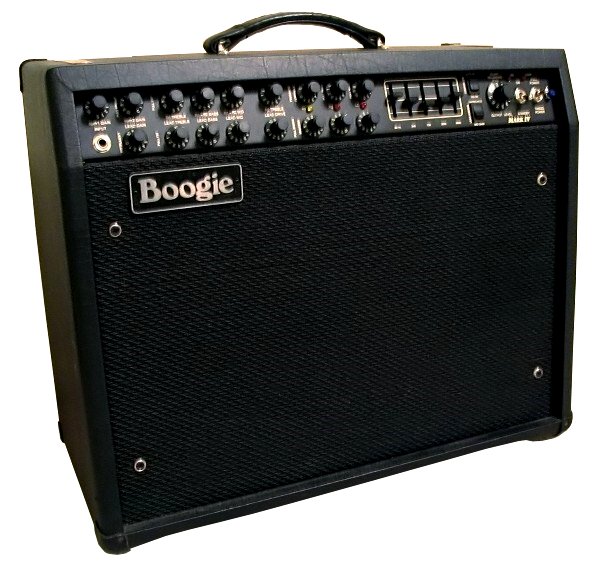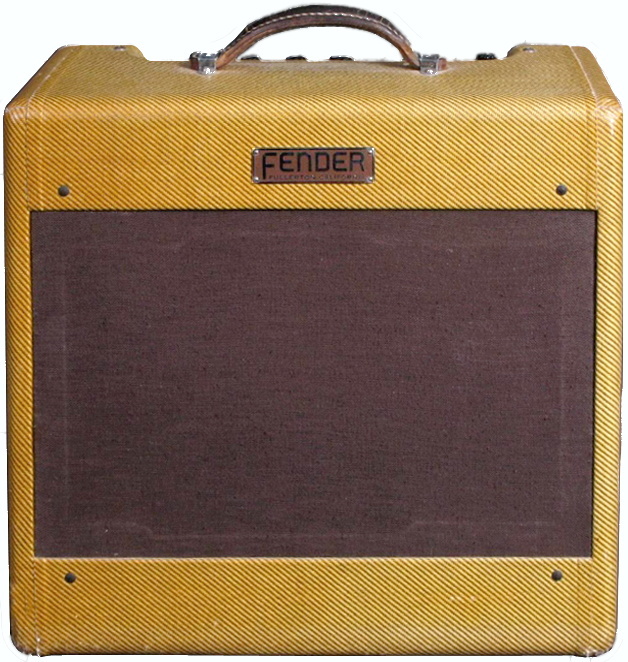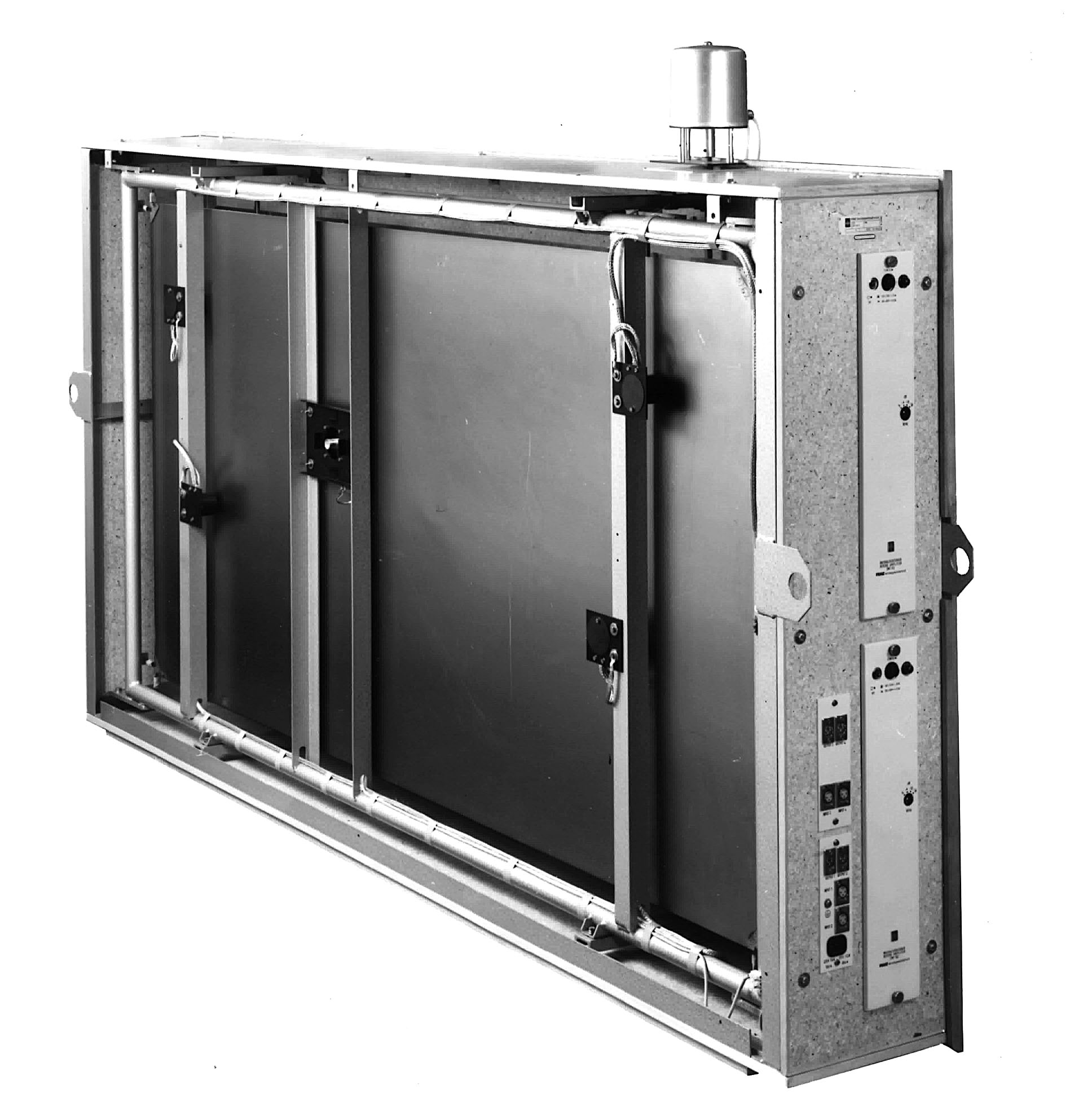|
Deluxe Reverb
The Fender Deluxe Reverb is a guitar amplifier made by the Fender Electric Instrument Company and its successors. It was first introduced in 1963 by incorporating an onboard spring reverb tank to the newly redesigned Fender Deluxe amplifier. Specifications The Deluxe Reverb is a 22-watt tube amplifier (at 8 ohms), powered by a pair ("duet") of 7408/ 6V6GT power tubes, one GZ34/5AR4 rectifier tube, four 7025/12AX7 tubes for preamplification and tremolo oscillation, and two 6201/12AT7 tubes driving the reverb and phase inverter circuits. Throughout its production, the amplifier has most often featured a Jensen C-12Q series 12-inch loudspeaker, although Oxford 12K5, Marlboro SE, Utah and Eminence speakers have also been used. The 22-watt output was obtained by operating the 6V6 power tubes well in excess of their maximum specified operating voltage. The amplifier weighs 42 pounds and measures 9.5" x 24.5" x 17.5". Variations The original Deluxe Reverb (circuits AA763, and later ... [...More Info...] [...Related Items...] OR: [Wikipedia] [Google] [Baidu] |
Guitar Amplifier
A guitar amplifier (or amp) is an electronic amplifier, electronic device or system that strengthens the electrical signal from a Pickup (music technology), pickup on an electric guitar, bass guitar, or acoustic guitar so that it can produce sound through one or more loudspeakers, which are typically housed in a wooden speaker enclosure, cabinet. A guitar amplifier may be a standalone wood or metal cabinet that contains only the power amplifier (and preamplifier) circuits, requiring the use of a separate speaker cabinet–or it may be a ''combo'' amplifier, which contains both the amplifier and one or more speakers in a wooden cabinet. There is a wide range of sizes and power ratings for guitar amplifiers, from small, lightweight practice amplifiers with a single 6-inch speaker and a 10-watt amp to heavy combo amps with four 10-inch or four 12-inch speakers and a 100-watt amplifier, which are loud enough to use in a nightclub or bar performance. Guitar amplifiers can also modify ... [...More Info...] [...Related Items...] OR: [Wikipedia] [Google] [Baidu] |
Fender Electric Instrument Company
The Fender Musical Instruments Corporation (FMIC, or simply Fender) is an American manufacturer and marketer of musical instruments and amplifiers. Fender produces acoustic guitars, bass amplifiers and public address equipment; however, it is best known for its solid-body electric guitars and bass guitars, particularly the Stratocaster, Telecaster, Jaguar, Jazzmaster, Precision Bass, and the Jazz Bass. The company was founded in Fullerton, California, by Clarence Leonidas "Leo" Fender in 1946. Andy Mooney has served as the chief executive officer (CEO) since June 2015. In January 2020, Servco Pacific became the majority owner after acquiring the shares of TPG Growth. History Origins The company began as "Fender's Radio Service" in late 1938, in Fullerton, California. As a qualified electronics technician, Fender had repaired radios, phonographs, home audio amplifiers, public address systems and musical instrument amplifiers, all designs based on research developed and relea ... [...More Info...] [...Related Items...] OR: [Wikipedia] [Google] [Baidu] |
Fender Deluxe
The Fender Deluxe guitar amplifier is a range of non-reverb guitar amplifiers produced by Fender. The amplifiers were originally produced from early 1948 to 1966 and reissues are in current production. Its predecessor was the Fender Model 26 "Woodie" produced from 1946 to 1948. Tweed Deluxe The Fender Deluxe amp of the 1950s was a medium-powered unit designed to let guitarists "hold their own" in a small group. As blues, western swing, Western, and rockabilly bands began getting louder, the overdriven tone of a cranked-up Deluxe found its way onto many live and recorded performances. The earliest version of the Deluxe was the 5A3, and is often referred to as having a TV Front appearance because the wide panels around the grill were like the television sets of the 1950s. This was true also of the smaller Fender Princeton student and studio amp introduced in 1946 and upgraded in 1948. Subsequent versions of the Deluxe were the "wide panel" cabinet design 5B3, 5C3, and 5D3, fo ... [...More Info...] [...Related Items...] OR: [Wikipedia] [Google] [Baidu] |
Valve Audio Amplifier
A valve audio amplifier ( UK) or vacuum tube audio amplifier ( US) is a valve amplifier used for sound reinforcement, sound recording and reproduction. Until the invention of solid state devices such as the transistor, all electronic amplification was produced by valve (tube) amplifiers. While solid-state devices prevail in most audio amplifiers today, valve audio amplifiers are still used where their audible characteristics are considered pleasing, for example in music performance or music reproduction. Instrument and vocal amplification Valve amplifiers for guitars (and to a lesser degree vocals and other applications) have different purposes from those of hi-fi amplifiers. The purpose is not necessarily to reproduce sound as accurately as possible, but rather to fulfill the musician's concept of what the sound should be. For example, distortion is almost universally considered undesirable in hi-fi amplifiers but may be considered a desirable characteristic in performance. ... [...More Info...] [...Related Items...] OR: [Wikipedia] [Google] [Baidu] |
Vacuum Tube
A vacuum tube, electron tube, thermionic valve (British usage), or tube (North America) is a device that controls electric current flow in a high vacuum between electrodes to which an electric voltage, potential difference has been applied. It takes the form of an evacuated tubular envelope of glass or sometimes metal containing electrodes connected to external connection pins. The type known as a thermionic tube or thermionic valve utilizes thermionic emission of electrons from a hot cathode for fundamental Electronics, electronic functions such as signal amplifier, amplification and current Rectifier, rectification. Non-thermionic types such as vacuum phototubes achieve electron emission through the photoelectric effect, and are used for such purposes as the detection of light and measurement of its intensity. In both types the electrons are accelerated from the cathode to the anode by the electric field in the tube. The first, and simplest, vacuum tube, the diode or Flem ... [...More Info...] [...Related Items...] OR: [Wikipedia] [Google] [Baidu] |
Rectifier
A rectifier is an electrical device that converts alternating current (AC), which periodically reverses direction, to direct current (DC), which flows in only one direction. The process is known as ''rectification'', since it "straightens" the direction of current. Physically, rectifiers take a number of forms, including Vacuum tube#Diodes, vacuum tube diodes, wet chemical cells, mercury-arc valves, stacks of copper and selenium rectifier, selenium oxide plates, Diode#Semiconductor diodes, semiconductor diodes, silicon-controlled rectifiers and other silicon-based semiconductor switches. Historically, even synchronous electromechanical switches and motor-generator sets have been used. Early radio receivers, called crystal radios, used a "Crystal detector#Cat whisker detector, cat's whisker" of fine wire pressing on a crystal of galena (lead sulfide) to serve as a point-contact rectifier or "crystal detector". Rectifiers have many uses, but are often found serving as component ... [...More Info...] [...Related Items...] OR: [Wikipedia] [Google] [Baidu] |
12AX7
12AX7 (also known as ECC83) is a miniature dual-triode vacuum tube with high voltage gain (electronics), gain. Developed around 1946 by RCA engineers in Camden, New Jersey, under developmental number A-4522, it was released for public sale under the 12AX7 identifier on September 15, 1947. The 12AX7 was originally intended as replacement for the 6SL7 family of dual-triode amplifier tubes for audio applications. As a popular choice for guitar tube amplifiers, its ongoing use in such equipment makes it one of the few small-signal vacuum tubes in continuous production since it was introduced. History The 12AX7 is a twin triode basically composed of two of the triodes from a 6AV6, a double diode triode. The 6AV6 is a miniature repackaging (with just a single cathode) of the triode and twin diodes from the octal 6SQ7 (a double-diode triode used in AM radios), which itself is very similar to the older type 75 triode-diode dating from 1930. Application The 12AX7 is a high-gain (typic ... [...More Info...] [...Related Items...] OR: [Wikipedia] [Google] [Baidu] |
12AT7
12AT7 (also known in Europe by the Mullard–Philips tube designation of ECC81) is a miniature nine-pin medium-gain (60) dual-triode vacuum tube popular in guitar amplifiers. It belongs to a large family of dual triode vacuum tubes which share the same pinout (EIA 9A), including in particular the very commonly used low- mu 12AU7 and high-mu 12AX7. The 12AT7 has somewhat lower voltage gain than the 12AX7, but higher transconductance and plate current, which makes it suitable for high-frequency applications. Originally the tube was intended for operation in VHF circuits, such as TV sets and FM tuners, as an oscillator/frequency converter, but it also found wide use in audio as a driver and phase-inverter in vacuum tube push–pull amplifier circuits. In television applications, beside the tuner section, it was used just like 12AU7, in vertical and horizontal time base, as line and frame oscillator, relay tube, separator, limiter and also as keyed and gated automatic gain contr ... [...More Info...] [...Related Items...] OR: [Wikipedia] [Google] [Baidu] |
Reverb Effect
A reverb effect, or reverb, is an effects unit, audio effect applied to a sound signal to simulate reverberation. It may be created through physical means, such as echo chambers, or electronically through audio signal processing. The American producer Bill Putnam is credited for the first artistic use of artificial reverb in music, on the 1947 song "Peg o' My Heart" by the Harmonicats. Plate reverb uses electromechanical transducers to create vibrations in large plates of sheet metal. Spring reverb, created with a series of mounted springs, is popular in surf music and dub reggae. Shimmer reverb, which Pitch shift, alters the pitch of the reverberated sound, is often used in ambient music. Convolution reverb uses impulse responses to record the reverberation of physical spaces and recreate them digitally. Gated reverb became a staple of 1980s pop music, used by drummers including Phil Collins. Varieties Echo chambers The first reverb effects, introduced in the 1930s, were ... [...More Info...] [...Related Items...] OR: [Wikipedia] [Google] [Baidu] |
Jensen Loudspeakers
Jensen Loudspeakers is a company that manufactures speakers in many different models and sizes. Originally located in Chicago, Illinois, the company built a reputation during the 50s and 60s providing speakers used mainly in guitar and bass amplifiers. Although the American company is long out of business, "reissue" guitar speakers are currently made in Italy by SICA Altoparlanti and distributed in the United States by CE Distribution. Jensen and Rola were, for a time both under common ownership (subsidiaries of the Muter Co.), and shared various design similarities. Their 8" and 15" baskets appeared to utilize the same tooling. Rola locations took over Jensen product manufacturing when the Chicago plant closed. The current Fender Twin Reverb amp uses two 12" Jensen C-12K speakers. History The former Jensen Radio Manufacturing Company was founded in 1927 by Peter Laurits Jensen, the co-inventor of the first loudspeaker, in Chicago, Illinois. The company gained popularity in its ... [...More Info...] [...Related Items...] OR: [Wikipedia] [Google] [Baidu] |
Loudspeaker
A loudspeaker (commonly referred to as a speaker or, more fully, a speaker system) is a combination of one or more speaker drivers, an enclosure, and electrical connections (possibly including a crossover network). The speaker driver is an electroacoustic transducer that converts an electrical audio signal into a corresponding sound. The driver is a linear motor connected to a diaphragm, which transmits the motor's movement to produce sound by moving air. An audio signal, typically originating from a microphone, recording, or radio broadcast, is electronically amplified to a power level sufficient to drive the motor, reproducing the sound corresponding to the original unamplified signal. This process functions as the inverse of a microphone. In fact, the ''dynamic speaker'' driver—the most common type—shares the same basic configuration as a dynamic microphone, which operates in reverse as a generator. The dynamic speaker was invented in 1925 by Edward W. Kellogg ... [...More Info...] [...Related Items...] OR: [Wikipedia] [Google] [Baidu] |







